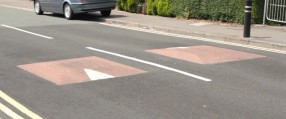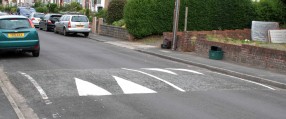Village Gateway - physical measures

Gateways with physical measures always include village name signage (to introduce drivers to the village), in addition to at least one of the following:
- Road narrowing
- A chicane
- Speed table or speed cushion
- Mini roundabout
The village gateway helps to create 'a sense of place' when drivers enter the village, and the physical measures are designed such that drivers are required to slow down before entry.
Disadvantages
- Relatively expensive, especially if drainage work is required
- Buses and emergency vehicles will need to slow down
- Some cyclists feel unsafe if road narrowing is used
Funding for Village Gateways
Somerset County Council may be able to fund the construction of Village Gateways. However, if the Council cannot fund a Gateway, Parish Councils or Community Groups can make a contribution from their own budgets. Developer contributions (S106), from new developments can also help with funding.

Restrictions
- Must be installed just outside the boundary of a village
- Space is required at the side of the road for the gateway sign
- Speed tables or speed cushions may not be feasible on rural roads
- This scheme might require a notice under the Road Hump Regulations legislation before it is installed (depending on which measures are used), which is subject to a local consultation process
There's also some general restrictions to note for all schemes
Advantages
- More effective than visual (signs/lines) treatments
- The village entrance and new speed limit is made more obvious to vehicle drivers

Effectiveness
Speeds
Physical measures at village gateways consistently reduce vehicle speeds very effectively. Types of physical measures can vary, but the best results will be expected from those which are vertical – a raised table for example.
- Raised tables are expected to reduce most vehicle speeds by around 4mph to 5mph
- Rumble strips can cause vibrations into any nearby houses, however they can be expected to reduce speeds by around 4 mph at a village gateway
Accidents
Any measures which reduce vehicle speeds will increase road safety. The measures above are very likely to improve road safety.
There is no robust research on physical gateways alone, only research where they were used in conjunction with traffic calming within the village. This research showed, however, that physical village gateway treatments used with traffic calming throughout a village are expected to reduce slight injury accidents and accidents where people were killed or seriously injured by more than 50%. This research was based on UK villages where road humps, speed cushions, chicanes and narrowings were used.
It is unknown what the effect on accidents would be if physical village gateway treatments were installed without traffic calming within the village. It could be expected that motor vehicles would speed up again within the village, and the accident reduction benefit would decrease to some extent.
Considerations
- May cause traffic to divert to other routes
- Some physical measures (e.g. rumble strips and speed tables) may create noise and vibration which is heard and felt in residences nearby
Advanced information
Some of the findings given are based on a good quality simulator research study into speed reducing treatments (Jamson et al., 2010). The research specifically compared UK treatments on UK style roads. The research findings are considered to be very conservative, as the study only recruited young (19 to 25 years old) male drivers – younger drivers, and specifically young male drivers are most likely to be speeding, therefore research which is found to be effective on this group is thought to be at least equally effective on other motor vehicle users. Results from this study are the basis for the speed reduction figure given for rumble strips.
The figure for speed tables is based upon research from the FHWA. The 4 to 5 mph reduction in vehicle speeds is for the 85th percentile. Speed reductions were very consistent across a 12 month time period, however there was no control point. The study used a large sample size at two sites.
For crash reduction at village gateways, all information is based on research from the Transportation Research Laboratory (TRL 452). For this study, multiple designs for traffic calming through villages were grouped based on similar characteristics. The study design is strong, with a large selection of sites, and long analysis periods before and after intervention. The research provides evidence that measures which move towards more physical elements are the most effective. The accident reduction figures given can only be used as a rough guide, as the village gateway measures compared on this page differ somewhat from those analysed in the research.
There’s a further noteworthy piece of research not mentioned above. TRL 641 studied ‘psychological traffic calming’. The report highlights traffic calming measures which increase cognitive load; create uncertainty; emphasise a change of environment; and break up linearity. The authors state that these elements reduce vehicle speeds considerably, due to the changes they have on the driver’s thought process. This research only backed up this theory with analysis of one village implementation in the U.K. – measures included; removing the centre line; build-outs with tree planting (to create a chicane effect); stone gateways to the village; and buff coloured road sections in pedestrian heavy areas.
Recommendation
Physical measures are more effective than just signs and lines alone. Physical measures are more expensive however, and could be unpopular with some residents and motorists.
Village gateways with physical measures (as outlined above) should only be explored after village gateways with signs and lines have been installed, and they haven't been effective.
Speed cameras can also be very effective at reducing vehicle speeds through a village.
References
TBC









